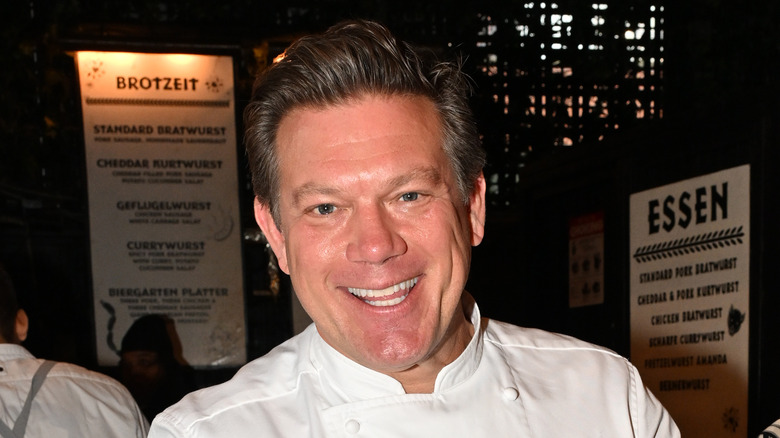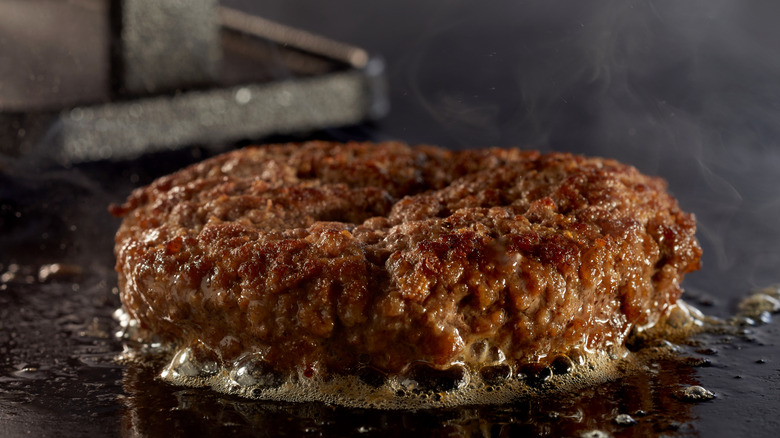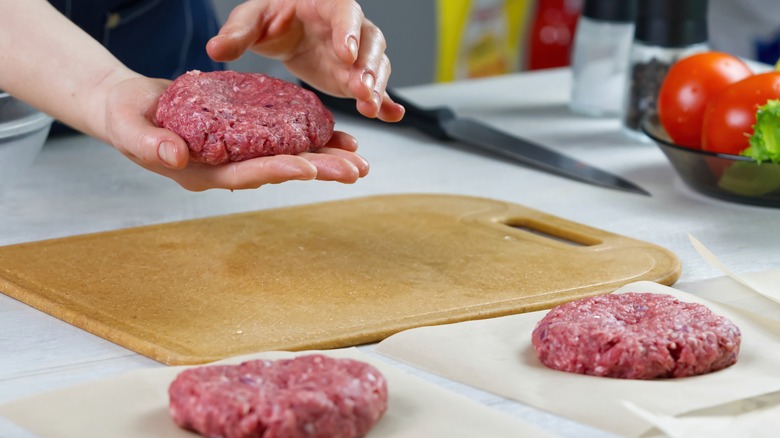Tyler Florence's Texture Tip For Perfect Burgers
Burgers are an all-time favorite meal, but what makes the perfect burger? It's difficult to say since many factors contribute: You can have a delicious, juicy hamburger grilled medium-rare one day, and the next, you might prefer a charred smashed burger. Even so, chef Tyler Florence thinks he's created the perfect burger, and, for him, it all comes down to texture.
To achieve the ideal texture, it's a combination of the meat blend, the size of the grinding plate, how the burger is cooked, and the dish's components, such as the bun. At Miller & Lux, Florence's San Francisco steakhouse, the kitchen uses a high percentage of fat in the burger blends. While most pre-made patties combine a ratio of 85/15 or 80/20 lean meat to fat, Miller & Lux uses a dry-aged 75/25 blend for its burgers. Since some of the fat is lost during cooking, this allows a juicy burger even if guests prefer it cooked well.
The kitchen at the restaurant also grinds the meat twice using a 3/8"-hole grinding plate, which is larger than the 1/8"-hole commonly used by U.S. butchers. The result is chopped meat with a fluffier texture reminiscent of sausage or chili meat instead of a dense meatball. The burger patties are gently formed and placed into the refrigerator until it's time to cook.
More of Tyler's tips for cooking the perfect burger
Tyler Florence has more tips for making the perfect burger. To enhance the texture and flavor of your burger further, you can cook it on a cast iron skillet, griddle, or plancha, just like Tyler Florence does. This increases the surface area in contact with the hot pan, allowing more of the meat to caramelize and develop crispy edges. You can use cast iron on an open flame, making it the perfect option for both indoor and outdoor cooking. Just confirm that the pan is sizzling hot before adding your patty, and gently press it with a spatula to ensure the surfaces are in contact.
Also ensure there's lots of grill marks. Also called "quadrillage," they aren't just there for show. They indicate that a chemical reaction has occurred that caramelizes the meat where it has been seared against the hot surface. This process locks in the meat's juices and helps it develop a deeper flavor.
When serving, the bun selection is just as important. The bun's texture should balance the burger's crispy exterior but not be so delicate that it falls apart when you pick it up. A squishy potato bun or buttery brioche roll are both good options that can be toasted to stand up to the burger's juices better. Florence prefers to use toasted, day-old brioche, which prevents the bun from dissolving.
Focus on the perfect burger blend
Tyler Florence sells a dry-aged burger at Miller & Lux for $34, but it's possible to make a delicious burger at home for much less by concentrating on the meat blend. After all, part of the appeal of the humble hamburger is that it's affordable; but for less than $8 per pound, you can combine two or more cuts such as sirloin, chuck, short rib, skirt, and brisket to create a tempting meal.
Start by grinding your own meat to have complete control over what you're serving. If you have a grinder attachment for your stand mixer, you can create a custom blend of burger meat that takes advantage of the flavors and fat content from different cuts. If not, your butcher can do it for you.
To keep the burgers moist and intact during cooking, combine a lean cut like sirloin with ones that have more fat and flavor, whether it's grassiness or umami you are looking for. Well-marbled meat from tough cuts like brisket, which usually requires slow-cooked braises to break down the muscle fibers, will keep the burgers moist. Add short rib for nuttiness or skirt steak for gaminess. The legendary Pat LaFrieda Meat Purveyors, which has been making its original 80/20 burger blend for over a century, combines chuck, brisket, and short rib from American Black Angus Beef to balance flavor and juiciness at any level of doneness.



